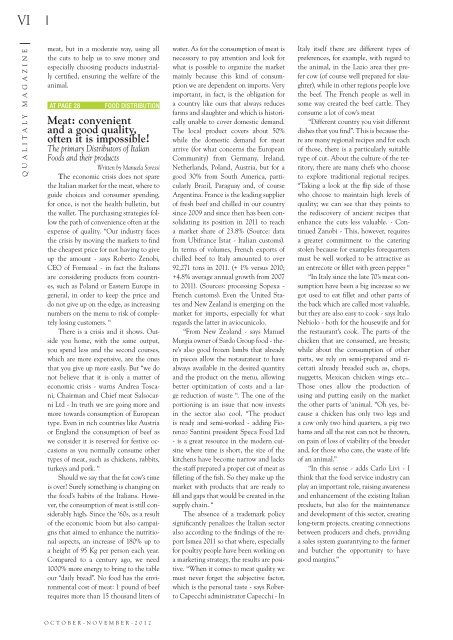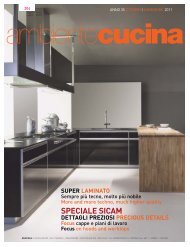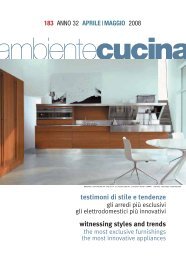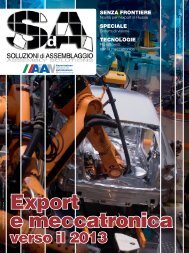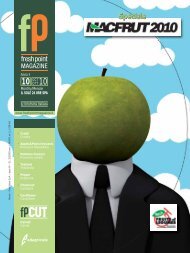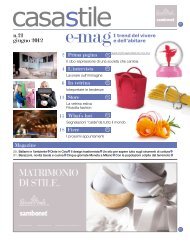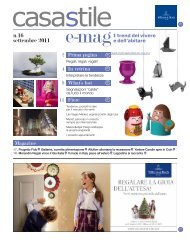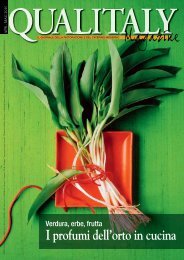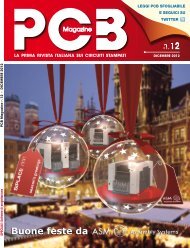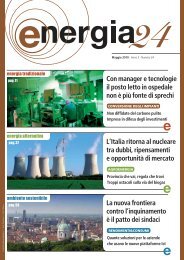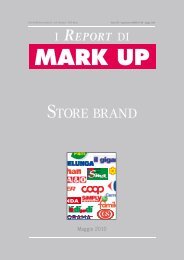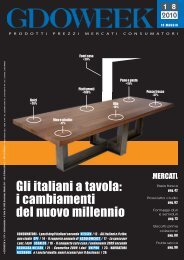Carne, voglia d'eccellenza - B2B24 - Il Sole 24 Ore
Carne, voglia d'eccellenza - B2B24 - Il Sole 24 Ore
Carne, voglia d'eccellenza - B2B24 - Il Sole 24 Ore
Create successful ePaper yourself
Turn your PDF publications into a flip-book with our unique Google optimized e-Paper software.
VI<br />
q u a l I t a l y m a g a z I n e<br />
meat, but in a moderate way, using all<br />
the cuts to help us to save money and<br />
especially choosing products industrially<br />
certified, ensuring the welfare of the<br />
animal.<br />
At pAge 28 food distribution<br />
Meat: convenient<br />
and a good quality,<br />
often it is impossible!<br />
The primary Distributors of Italian<br />
Foods and their products<br />
Written by Manuela Soressi<br />
The economic crisis does not spare<br />
the Italian market for the meat, where to<br />
guide choices and consumer spending,<br />
for once, is not the health bulletin, but<br />
the wallet. the purchasing strategies follow<br />
the path of convenience often at the<br />
expense of quality. “our industry faces<br />
the crisis by moving the markets to find<br />
the cheapest price for not having to give<br />
up the amount - says roberto zenobi,<br />
ceo of Formasal - in fact the Italians<br />
are considering products from countries,<br />
such as Poland or eastern europe in<br />
general, in order to keep the price and<br />
do not give up on the edge, as increasing<br />
numbers on the menu to risk of completely<br />
losing customers. “<br />
there is a crisis and it shows. outside<br />
you home, with the same output,<br />
you spend less and the second courses,<br />
which are more expensive, are the ones<br />
that you give up more easily. but “we do<br />
not believe that it is only a matter of<br />
economic crisis - warns andrea toscani,<br />
chairman and chief meat Salsocarni<br />
ltd - In truth we are going more and<br />
more towards consumption of european<br />
type. even in rich countries like austria<br />
or england the consumption of beef as<br />
we consider it is reserved for festive occasions<br />
as you normally consume other<br />
types of meat, such as chickens, rabbits,<br />
turkeys and pork. “<br />
Should we say that the fat cow’s time<br />
is over? Surely something is changing on<br />
the food’s habits of the Italians. However,<br />
the consumption of meat is still considerably<br />
high. Since the ‘60s, as a result<br />
of the economic boom but also campaigns<br />
that aimed to enhance the nutritional<br />
aspects, an increase of 180% up to<br />
a height of 95 Kg per person each year.<br />
compared to a century ago, we need<br />
1000% more energy to bring to the table<br />
our “daily bread”. no food has the environmental<br />
cost of meat: 1 pound of beef<br />
requires more than 15 thousand liters of<br />
o c t o b e r - n o V e m b e r - 2 0 1 2<br />
water. as for the consumption of meat is<br />
necessary to pay attention and look for<br />
what is possible to organize the market<br />
mainly because this kind of consumption<br />
we are dependent on imports. Very<br />
important, in fact, is the obligation for<br />
a country like ours that always reduces<br />
farms and slaughter and which is historically<br />
unable to cover domestic demand.<br />
the local product covers about 50%<br />
while the domestic demand for meat<br />
arrive (for what concerns the european<br />
community) from germany, Ireland,<br />
netherlands, Poland, austria, but for a<br />
good 30% from South america, particularly<br />
brazil, Paraguay and, of course<br />
argentina. France is the leading supplier<br />
of fresh beef and chilled in our country<br />
since 2009 and since then has been consolidating<br />
its position in 2011 to reach<br />
a market share of 23.8% (Source: data<br />
from ubifrance Istat - Italian customs).<br />
In terms of volumes, French exports of<br />
chilled beef to Italy amounted to over<br />
92,271 tons in 2011. (+ 1% versus 2010;<br />
+4.8% average annual growth from 2007<br />
to 2011). (Sources: processing Sopexa -<br />
French customs). even the united States<br />
and new zealand is emerging on the<br />
market for imports, especially for what<br />
regards the latter in aviocunicolo.<br />
“From new zealand - says manuel<br />
murgia owner of Sardo group food - there’s<br />
also good frozen lambs that already<br />
in pieces allow the restaurateur to have<br />
always available in the desired quantity<br />
and the product on the menu, allowing<br />
better optimization of costs and a large<br />
reduction of waste “. the one of the<br />
portioning is an issue that now invests<br />
in the sector also cool. “the product<br />
is ready and semi-worked - adding Fiorenzo<br />
Santini president Speca Food ltd<br />
- is a great resource in the modern cuisine<br />
where time is short, the size of the<br />
kitchens have become narrow and lacks<br />
the staff prepared a proper cut of meat as<br />
filleting of the fish. So they make up the<br />
market with products that are ready to<br />
fill and gaps that would be created in the<br />
supply chain. “<br />
the absence of a trademark policy<br />
significantly penalizes the Italian sector<br />
also according to the findings of the report<br />
Ismea 2011 so that where, especially<br />
for poultry people have been working on<br />
a marketing strategy, the results are positive.<br />
“When it comes to meat quality we<br />
must never forget the subjective factor,<br />
which is the personal taste - says roberto<br />
capecchi administrator capecchi - In<br />
Italy itself there are different types of<br />
preferences, for example, with regard to<br />
the animal, in the lazio area they prefer<br />
cow (of course well prepared for slaughter),<br />
while in other regions people love<br />
the beef. the French people as well in<br />
some way created the beef cattle. they<br />
consume a lot of cow’s meat<br />
“Different country you visit different<br />
dishes that you find”. this is because there<br />
are many regional recipes and for each<br />
of those, there is a particularly suitable<br />
type of cut. about the culture of the territory,<br />
there are many chefs who choose<br />
to explore traditional regional recipes.<br />
“taking a look at the flip side of those<br />
who choose to maintain high levels of<br />
quality; we can see that they points to<br />
the rediscovery of ancient recipes that<br />
enhance the cuts less valuable. - continued<br />
zanobi - this, however, requires<br />
a greater commitment to the catering<br />
stolen because for examples forequarters<br />
must be well worked to be attractive as<br />
an entrecote or fillet with green pepper “<br />
“In Italy since the late 70’s meat consumption<br />
have been a big increase so we<br />
got used to eat fillet and other parts of<br />
the back which are called most valuable,<br />
but they are also easy to cook - says Italo<br />
nebiolo - both for the housewife and for<br />
the restaurant’s cook. the parts of the<br />
chicken that are consumed, are breasts;<br />
while about the consumption of other<br />
parts, we rely on semi-prepared and ricettati<br />
already breaded such as, chops,<br />
nuggetts, mexican chicken wings etc...<br />
those ones allow the production of<br />
using and putting easily on the market<br />
the other parts of ‘animal. “oh yes, because<br />
a chicken has only two legs and<br />
a cow only two hind quarters, a pig two<br />
hams and all the rest can not be thrown,<br />
on pain of loss of viability of the breeder<br />
and, for those who care, the waste of life<br />
of an animal.”<br />
“In this sense - adds carlo livi - I<br />
think that the food service industry can<br />
play an important role, raising awareness<br />
and enhancement of the existing Italian<br />
products, but also for the maintenance<br />
and development of this sector, creating<br />
long-term projects, creating connections<br />
between producers and chefs, providing<br />
a sales system guarantying to the farmer<br />
and butcher the opportunity to have<br />
good margins.”


